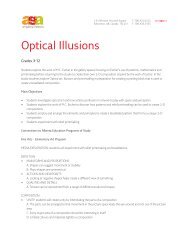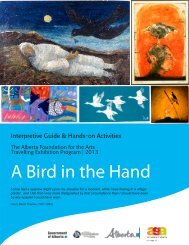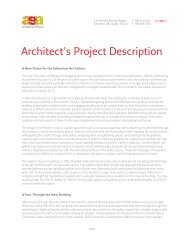Down on the Farm - Art Gallery of Alberta
Down on the Farm - Art Gallery of Alberta
Down on the Farm - Art Gallery of Alberta
- No tags were found...
You also want an ePaper? Increase the reach of your titles
YUMPU automatically turns print PDFs into web optimized ePapers that Google loves.
The <strong>Alberta</strong> Foundati<strong>on</strong> for <strong>the</strong> <strong>Art</strong>s Travelling Exhibiti<strong>on</strong> ProgramWhat is Visual Learning?All art has many sides to it. The artist makes <strong>the</strong> works for people to experience. They in turncan make discoveries about both <strong>the</strong> work and <strong>the</strong> artist that help <strong>the</strong>m learn and give <strong>the</strong>mpleasure for a l<strong>on</strong>g time.How we look at an object determines what we come to know about it. We remember informati<strong>on</strong>about an object far better when we are able to see (and handle) objects ra<strong>the</strong>r than by <strong>on</strong>lyreading about <strong>the</strong>m. This investigati<strong>on</strong> through observati<strong>on</strong> (looking) is very important toundertanding how objects fit into our world in <strong>the</strong> past and in <strong>the</strong> present and will help viewersreach a c<strong>on</strong>sidered resp<strong>on</strong>se to what <strong>the</strong>y see. The following is a six-step method to lookingat, and understanding, a work <strong>of</strong> art.STEP 1: INITIAL, INTUITIVE RESPONSE The first ‘gut level’ resp<strong>on</strong>se to a visual presentati<strong>on</strong>.What do you see and what do you think <strong>of</strong> it?STEP 2: DESCRIPTION Naming facts - a visual inventory <strong>of</strong> <strong>the</strong> elements <strong>of</strong> design.Questi<strong>on</strong>s to Guide Inquiry:What colours do you see? What shapes are most noticeable?What objects are most apparent? Describe <strong>the</strong> lines in <strong>the</strong> work.STEP 3: ANALYSIS Exploring how <strong>the</strong> parts relate to each o<strong>the</strong>r.Questi<strong>on</strong>s to Guide Inquiry:What proporti<strong>on</strong>s can you see? eg. What percentage <strong>of</strong> <strong>the</strong> work is background? Foreground?Land? Sky? Why are <strong>the</strong>re <strong>the</strong>se differences? What effect do <strong>the</strong>se differences create?What parts seem closest to you? Far<strong>the</strong>st away? How does <strong>the</strong> artist give this impressi<strong>on</strong>?STEP 4: INTERPRETATION Exploring what <strong>the</strong> work might mean or be about.Questi<strong>on</strong>s to Guide Inquiry:How does this work make you feel? Why?What word would best describe <strong>the</strong> mood <strong>of</strong> this work?What is this painting/photograph/sculpture about?Is <strong>the</strong> artist trying to tell a story? What might be <strong>the</strong> story in this work?STEP 5: INFORMATION Looking bey<strong>on</strong>d <strong>the</strong> work for informati<strong>on</strong> that may fur<strong>the</strong>runderstanding.Questi<strong>on</strong>s to Guide Inquiry:What is <strong>the</strong> artist’s name? When did he/she live?What art style and medium does <strong>the</strong> artist use?What artist’s work is this artist interested in?What art was being made at <strong>the</strong> same time as this artist was working?What was happening in history at <strong>the</strong> time this artist was working?What social/political/ec<strong>on</strong>omic/cultural issues is this artist interested in?STEP 6: PERSONALIZATION What do I think about this work? (Reaching a c<strong>on</strong>sideredresp<strong>on</strong>se).© Virginia StephenAFA Travelling Exhibiti<strong>on</strong> Program, Edm<strong>on</strong>t<strong>on</strong>, AB. Ph: 780.428.3830 Fax: 780.421.0479youraga.ca
















